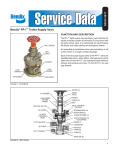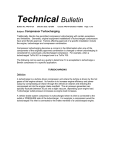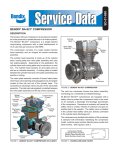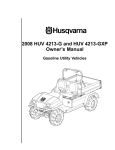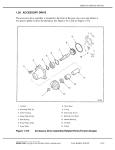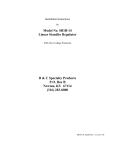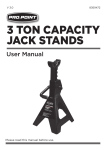Download BENDIX BW1552 User's Manual
Transcript
SD-01-3408 ® Bendix® Inlet Regulating Valve or IRV™ for Compressors VENT OUTLET FLANGE (MATES TO COMPRESSOR INLET) MOUNTING HOLE MOUNTING HOLE OUTLET SAFETY VALVE TURBOCHARGER SUPPLY PORT 3/4” NPT FIGURE 1 - COMPRESSOR INLET REGULATING VALVE BODY O-RING O-RING OR VALVE & U-CUP PISTON PISTON HOUSING ASSEMBLY O-RING VALVE O-RING OUTLET VALVE SEAT O-RING SPRING VALVE SAFETY SPRING VALVE EXHAUST PLUG SPACER O-RING CAP NUT TURBOCHARGER SUPPLY PORT FIGURE 2 - INLET REGULATING VALVE DESCRIPTION The IRV™ inlet regulating valve is intended for use on multi-cylinder compressors which receive their induction air supply from the pressure side of the engine turbocharger. The IRV™ valve may not be used in conjunction with single cylinder compressors including the Bendix® BX-2150™ compressor. Generally mounted directly at the compressor air inlet, the IRV™ valve is designed to regulate compressor inlet pressure to 10 psi or less. The cast aluminum body incorporates an outlet flange which is capable of mating with all Bendix compressor inlet flanges except that of the Tu-Flo® 300 compressor. A 3/4 inch female pipe thread in the IRV™ valve cap nut facilitates connection to the engine induction system or turbocharger. High 1 temperature o-rings, seals, seats, and lubricant are used throughout the IRV™ valve to provide compatibility with incoming turbocharger air temperatures up to 250°F. The unitized valve and piston assembly consists of the piston housing, two o-rings and control piston with its permanently affixed valve plate. The cavity below the piston is vented to atmosphere. The ring spacer holds the piston housing in place and rests on the supply cap nut along with the valve spring. The steel cap nut contains the supply port and retains an o-ring which serves as the valve seat. A hex socket plug with a through drilled vent along with a spring and steel ball valve comprise the safety valve. PISTON VALVE PLATE OUTLET TO COMPRESSOR SEAT SPRING OPERATION TURBOCHARGER SUPPLY GENERAL The IRV™ valve maintains a low pressure at the compressor inlet (10 psi or less) regardless of turbocharger supply air pressure. The air flow through the IRV™ valve is throttled by COMPRESSOR LOADED HIGH TURBOCHARGER PRESSURE (Figure 4) PISTON VALVE PLATE SPRING SEAT OUTLET TO COMPRESSOR FIGURE 4 - COMPRESSOR LOADEDHIGH TURBOCHARGER PRESSURE TURBOCHARGER SUPPLY FIGURE 3 - COMPRESSOR EITHER LOADED OR UNLOADED WITH LOW TURBOCHARGER PRESSURE Air at turbocharger supply pressure is continually supplied to the chamber above the IRV™ valve piston. At pressures above 5 psi the force on the piston is sufficient to partially close the valve. With the compressor loaded (compressing air) the resulting pressure drop across the valve lowers the delivery pressure to the compressor. This lower pressure is effective over the upper surface of the valve plate, tending to open the valve. The pressure drop across the valve increases with increased compressor flow (higher compressor RPM). The position of the valve is thus affected by both turbo supply pressure and compressor air demand. High turbo supply pressure coupled with low compressor air demand will tend to close the valve. COMPRESSOR UNLOADED HIGH TURBOCHARGER PRESSURE (Figure 5) the valve which varies in position from fully open to closed. Valve position and, therefore, the degree of throttling is controlled by both turbocharger supply pressure and compressor air flow demand. The operation of the IRV™ valve is described for each of four functional conditions. COMPRESSOR EITHER LOADED OR UNLOADED LOW TURBOCHARGER PRESSURE (Figure 3) For both loaded and unloaded compressor operation at low turbocharger pressure (Less than 5 psi) the IRV™ valve remains fully open. Air is supplied to the compressor at turbo supply pressure. The position of the piston/valve plate assembly is determined by the pressure forces acting on the top of the piston, on the upper and lower valve plate surfaces, and by the spring force. At low supply pressure the thrust of the pressure forces is insufficient to overcome the spring force. 2 PISTON VALVE PLATE SEAT OUTLET TO COMPRESSOR SPRING TURBOCHARGER SUPPLY FIGURE 5 - COMPRESSOR UNLOADEDHIGH TURBOCHARGER PRESSURE OUTLET TO COMPRESSOR 3. 4. TURBOCHARGER SUPPLY FIGURE 6 - SAFETY VALVE OPERATION With the compressor unloaded air demand ceases and the IRV™ valve closes as turbo supply pressure exceeds 5 psi. The valve will close at a pressure between 5 and 10 psi and remain closed at higher pressures, allowing only a minute flow to compensate for compressor piston ring blow-by in the unloaded mode. At the compressor inlet, pressure is maintained at less than 10 psi. 5. 6. 7. SAFETY VALVE OPERATION (Figure 6) If for any reason pressure at the compressor inlet is excessive, the safety valve located in the IRV™ valve outlet flange will open. Pressure in excess of 18 psi will allow air to be exhausted to atmosphere. 8. PREVENTIVE MAINTENANCE Important: Review the Bendix Warranty Policy before performing any intrusive maintenance procedures. A warranty may be voided if intrusive maintenance is performed during the warranty period. No two vehicles operate under identical conditions, as a result, maintenance intervals may vary. Experience is a valuable guide in determining the best maintenance interval for air brake system components. At a minimum, the IRV™ valve should be inspected every 6 months or 1500 operating hours, whichever comes first, for proper operation. Should the IRV™ valve not meet the elements of the operational tests noted in this document, further investigation and service of the valve may be required. WARNING! PLEASE READ AND FOLLOW THESE INSTRUCTIONS TO AVOID PERSONAL INJURY OR DEATH: When working on or around a vehicle, the following general precautions should be observed at all times. 1. Park the vehicle on a level surface, apply the parking brakes, and always block the wheels. Always wear safety glasses. 2. Stop the engine and remove ignition key when working under or around the vehicle. When 9. 10. working in the engine compartment, the engine should be shut off and the ignition key should be removed. Where circumstances require that the engine be in operation, EXTREME CAUTION should be used to prevent personal injury resulting from contact with moving, rotating, leaking, heated or electrically charged components. Do not attempt to install, remove, disassemble or assemble a component until you have read and thoroughly understand the recommended procedures. Use only the proper tools and observe all precautions pertaining to use of those tools. If the work is being performed on the vehicle’s air brake system, or any auxiliary pressurized air systems, make certain to drain the air pressure from all reservoirs before beginning ANY work on the vehicle. If the vehicle is equipped with an AD-IS™ air dryer system or a dryer reservoir module, be sure to drain the purge reservoir. Following the vehicle manufacturer’s recommended procedures, deactivate the electrical system in a manner that safely removes all electrical power from the vehicle. Never exceed manufacturer’s recommended pressures. Never connect or disconnect a hose or line containing pressure; it may whip. Never remove a component or plug unless you are certain all system pressure has been depleted. Use only genuine Bendix ® replacement parts, components and kits. Replacement hardware, tubing, hose, fittings, etc. must be of equivalent size, type and strength as original equipment and be designed specifically for such applications and systems. Components with stripped threads or damaged parts should be replaced rather than repaired. Do not attempt repairs requiring machining or welding unless specifically stated and approved by the vehicle and component manufacturer. Prior to returning the vehicle to service, make certain all components and systems are restored to their proper operating condition. 1/8” NPT CONNECTION COMPRESSOR INLET MOUNTING HOLE(2) FIGURE 7 - COMPRESSOR INLET ADAPTER PART NO. 236701 3 COMPRESSOR INLET CAVITY TEST GAUGE A AIR LINE QUICK COUPLER ADAPTER (236701) INLET GASKETS (243430) TYPICAL MULTI-CYLINDER COMPRESSOR IRV TEST GAUGE B PRESSURE REGULATING VALVE TO SHOP AIR FIGURE 8 - IRV™ VALVE TEST APPARATUS OPERATION & LEAKAGE TESTS (Figures 7 & 8) GENERAL In order to test the operation of the IRV™ valve it will be necessary to install the equipment and apparatus as illustrated in Figure 8. The Bendix compressor inlet adapter in Figures 7 and 8 can be obtained at the nearest Bendix parts outlet. In most cases the inlet adapter will be required, however, if the IRV™ valve being tested has a 1/8 inch NPT access port in the area of its flange, the adapter is not needed. In addition to the inlet adapter two test gauges of known accuracy and a pressure regulating valve capable of graduation in the 5-30 psi range will be required to complete the tests. LEAKAGE TESTS (FIGURE 8) 1. With the engine off and vehicle air system pressure above 15 psi, apply 15 psi shop air pressure at the turbo supply port of the IRV™ valve. When pressure stabilizes on test gauge ‘A’, proceed to Step 2. 4 2. Using a soap solution check for leakage at the IRV™ valve vent in the body, around the two inch cap nut and at the exhaust plug of the safety valve. Leakage in excess of a one inch bubble in one second is unacceptable. OPERATIONAL TESTS (FIGURE 8) 1. Drain the air pressure from the vehicle reservoirs. 2. Apply 25 psi shop air pressure to the turbo supply port of the IRV™ valve, start the engine and allow it to run at an idle (approximately 600-700 RPM). When vehicle air system pressure rises above 25 psi, proceed to Step 3. 3. Using the pressure regulating valve and test gauge B, adjust the shop air pressure being delivered to the IRV™ valve in 5 psi increments between 5 and 25 psi. Pause 15-20 seconds at each pressure setting and note that the compressor inlet pressure, as indicated by test gauge ‘A’, is 12 psi or less. If the pressure exceeds 12 psi more than momentarily, the IRV™ valve should be repaired or replaced. Note: The tests described in this step must be made with the compressor loaded. 4. Adjust shop air to the IRV™ valve to 5 psi and allow the compressor to build the vehicle air system pressure to governor cut-out and note that the compressor unloads. With the compressor unloaded increase the shop air pressure to the IRV™ valve in 5 psi increments up to 25 psi. Pause 15-20 seconds at each pressure setting and note that the compressor inlet pressure as indicated by test gauge ‘A’ is 12 psi or less. If the pressure exceeds 12 psi more than momentarily, the IRV™ valve should be repaired or replaced. Note: The tests described in this step must be made with the compressor unloaded. 5. Test the function of the IRV™ valve safety. Turn off the engine and simultaneously apply shop air pressure to the IRV™ valve turbo supply port and to the compressor inlet (through the inlet adapter 236701). Beginning at 5 psi, slowly raise the pressure at both locations simultaneously until an exhaust of air is heard at the IRV™ valve’s safety valve. Note the pressure on gauge ‘A’ when the exhaust is heard. If exhaust occurs below 18 psi or above 25 psi, the IRV™ valve must be repaired or replaced. BODY VALVE O-RING O-RING SPRING EXHAUST PLUG VALVE & PISTON ASSEMBLY SPRING SPACER REMOVAL 1. Park the vehicle on a level surface and block the wheels and/or hold the vehicle by means other than the air brakes. O-RING VALVE SEAT (O-RING) 2. Drain the air pressure from all vehicle reservoirs. 3. Disconnect the turbocharged air line at the 3/4 inch NPT turbo supply port of the IRV™ valve. 4. Remove the two cap screws that secure the IRV valve, then remove the valve itself. CAP NUT ™ INSTALLATION FIGURE 9 - INLET REGULATING VALVE 1. Install a new gasket on the mounting flange of the IRV™ valve and using two cap screws secure the IRV™ valve. Note: If 5/16 inch cap screws are used to secure the IRV™ valve to the compressor inlet, torque the cap screws to between 125 and 150 pound inches. 1. Using an adjustable or two inch wrench remove the cap nut from the body. 2. Reconnect the turbocharged air line to the 3/4 inch NPT turbo supply port of the IRV™ valve. 4. Taking care not to damage the roll crimp of the cap nut, remove the small diameter o-ring which serves as the valve seat. 3. Before placing the vehicle in service, close all reservoir drain cocks and build air system pressure to governor cut-out. DISASSEMBLY (FIGURE 9) The following disassembly instructions are presented for reference purposes. Actual disassembly should not be undertaken without having the necessary maintenance kit and instructions available. Refer to Figure 9 throughout disassembly. 2. Remove the spring and spacer. 3. Remove the large diameter o-ring located beneath the hex head of the cap nut. 5. Gently tap the open end of the valve body on a nonmetallic surface in order to remove the valve and piston assembly. 6. Remove the large and small diameter o-rings from the exterior of the valve and piston assembly. NOTE: No further disassembly of the valve and piston assembly should be attempted. The detail parts of this assembly are NON-SERVICEABLE. 7. Using a 3/16 inch Allen wrench, remove the exhaust plug. 8. Remove the valve spring and valve. 5 CLEANING & INSPECTION ASSEMBLY 1. Using mineral spirits, clean and thoroughly dry all metal parts with the EXCEPTION of the VALVE AND PISTON ASSEMBLY. The valve and piston assembly contain o-rings, therefore, wipe the exterior of the exposed areas avoiding the bore in which the piston slides since a special high temperature lubricant is used on that surface. The appropriate lubricant is packaged in Bendix maintenance kits and should be used as directed in the kit instruction sheet. Refer to Figure 9 throughout assembly. 2. Using a thin wire make certain that the vent holes in the IRV™ valve body and valve and piston assembly are open. 3. Check all metal parts for severe corrosion, pitting and cracks. Pay particular attention to the valve springs and valve surfaces. Superficial corrosion and shallow pitting on the exterior of the cap nut and body is acceptable. 1. Lubricate the interior bore of the body and the o-ring grooves of the valve and piston assembly. 2. Lubricate and install the large and small diameter o-rings on the valve and piston assembly. 3. Carefully insert the valve and piston assembly into the body, making certain that it is completely seated and the valve plate remains visible. 4. Carefully work the small diameter o-ring, which serves as the valve seat, into the cap nut groove. When properly installed, this o-ring is evenly retained by the rolled over crimped edges of the cap nut groove. IMPORTANT: Do not Lubricate this o-ring or the cap nut groove in which it is installed. 5. Lubricate the cap nut groove for the large diameter o-ring. Lubricate, then install the large diameter o-ring on the cap nut. 6. Install the spacer then the spring in the valve body. 7. Install the cap nut in the body and torque it to between 58 and 72 pound feet. 8. Install the safety valve and valve spring in the IRV™ valve body. Using a 3/16 inch Allen wrench, install the exhaust plug. 9. Perform the operation and leakage tests before placing the valve in service. 6 BW1552 © 2004 Bendix Commercial Vehicle Systems LLC All rights reserved. 3/2004 Printed in U.S.A.






